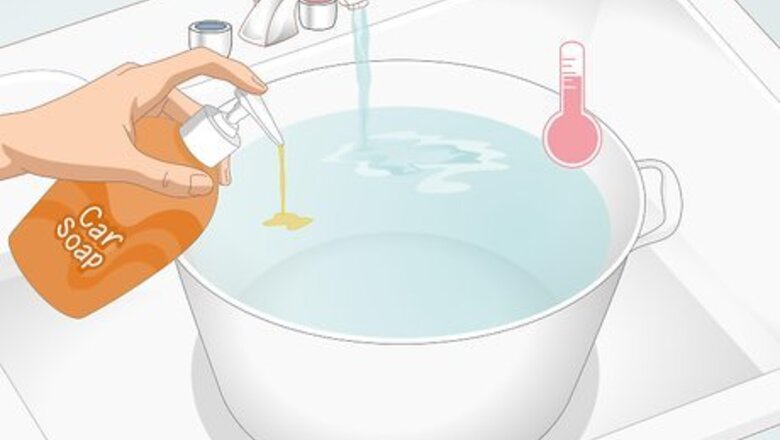
views
Cleaning Your Wheels
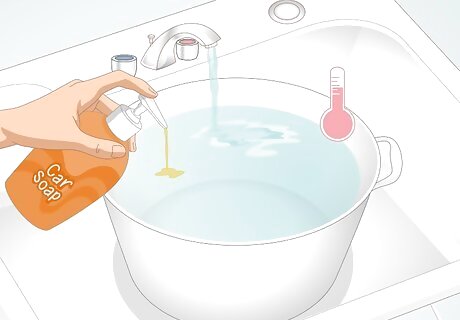
Fill a bucket with warm water and car soap. Before you can polish your wheels, clean them off to ensure that you don’t trap any dirt or grime in the surface of your chrome. Fill a bucket with warm or lukewarm water. Then, squirt car soap into the water. Use roughly 1 fl oz (30 mL) of car soap for every 1 US gal (3.8 L) of water.Variation: Instead of using soap and water, you can use a foam wheel spray. Get a can of foam wheel spray from an auto parts store and apply the spray by holding the can 8–12 inches (20–30 cm) away from the wheel. Shake the can as you apply it and wait 3-5 seconds after applying the spray for the foam to expand before rinsing it off. Don’t worry about it if you use too little or too much soap. So long as the water is a little bubbly, you should be fine. It’s best to do this in your driveway or on a quiet street since you’re going to be applying a lot of water to your wheels. You’re going to end up with a damp and humid garage if you do this indoors.
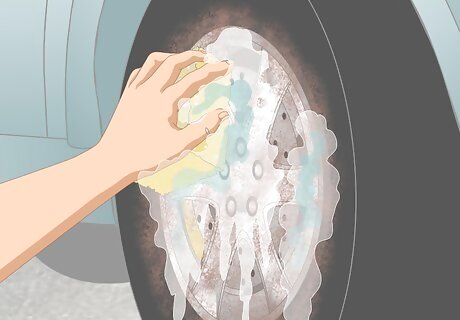
Apply the soap to each of your wheels with a large sponge. Grab a large, clean sponge. Dip it in the water and move it around to mix the water and soap. Then, rub each of your wheels with the sponge. Start on the exterior edge of your rims and work your way towards the center of the wheel to apply soap to each surface. You can use a thick towel if you prefer. This may be a better option if you have a wheel with more than 5-6 individual spokes since it’s easier to wrap a cloth around a spoke. Don’t worry about cleaning areas behind the rim that you can’t see. However, you can clean these areas if you’d like. Reload your sponge as needed to keep it wet and soapy.
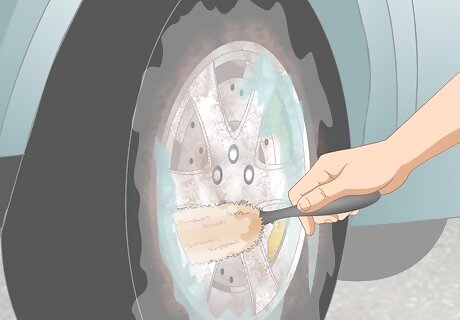
Use a soft wheel brush to clean hard-to-reach areas. A wheel brush is a thin handheld brush designed to clean vehicle wheels without scratching them. Get a wheel brush with soft bristles. Dip the brush into your bucket and insert it around the edges of your spokes. Use back-and-forth strokes to scrub along hard edges and tough-to-reach places that a sponge or cloth would struggle to thoroughly clean. Use the tip of your brush to your clean around your lug nuts as well. These nuts can be kind of hard to clean around, but you’re better off keeping them on the wheel as you do this. If you remove them and mess with the threading, the nuts may be more prone to sliding off in the future. Purchase a soft-bristled wheel brush online or from your local auto supply store.
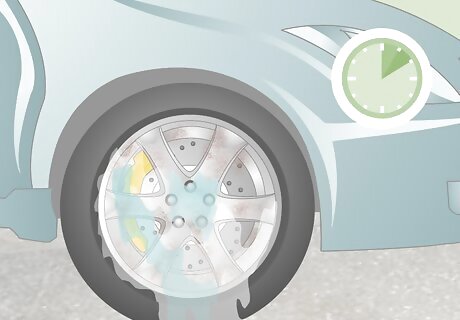
Wait 5-10 minutes to let the soap eat away at the dirt. Once you’ve used your sponge and brush to apply the soap, give the soap 5-10 minutes to eat into the dirt and grime. This will make it easier to rinse the residue off. If you don’t wait for a few minutes, tough collections of dirt or grime may need to be physically scraped away. This could damage or chip your chrome finish.
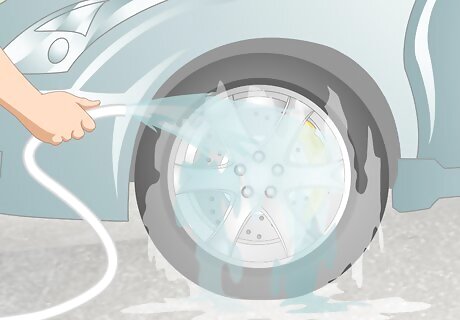
Rinse your wheels off to remove the soap residue. Either clean out your bucket to remove the soap before refilling it or grab a hose. Then, rinse your wheels with room-temperature or lukewarm water. Either hose your wheels down with a thin spray or toss water on to your wheels with your bucket. Alternatively, you can soak a large towel in clean water and rub your wheels by starting at the top of each rim and working your way down. Use as much water as necessary to remove the soapy residue on your wheels.
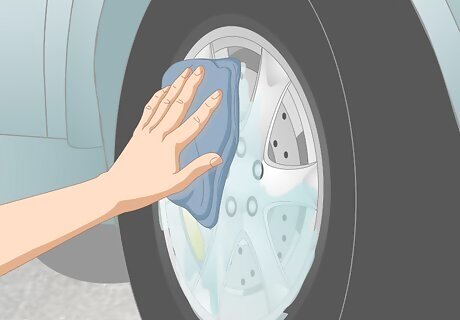
Dry your wheels off using compressed air or a clean cloth. Grab a large, clean cloth and rub your wheels down to remove the excess water. Replace the cloth as needed to ensure that you aren’t simply spreading moisture around with a damp cloth. If you have an air compressor, turn it on and hold the nozzle 12–24 inches (30–61 cm) away from each wheel and move the nozzle around in a circular motion to blow the water off. It’s not ideal to let your wheels air dry since you may end up with water spots on your wheel.
Polishing Your Chrome
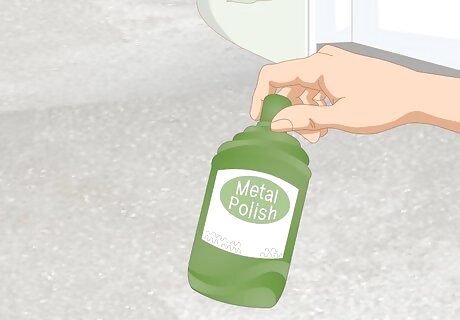
Get a metal polish designed for chrome or chrome wheels. Any metal polish that lists chrome on its label will work for polishing your wheels. There are specialty polishes designed for vehicle wheels, but they’re essentially the same thing as standard chrome polishes. Read the label on a bottle of polish carefully to ensure that the polish will work with chrome. Get a chrome polish online or from your local auto parts store. You can also find a chrome polish at a home repair shop. Instead of a polish, you can also use a car compound if you prefer. Compounds are a more abrasive cleaning agent that will do a better job of removing scratches, but your wheels may not hold up as well over time. Some compounds won’t protect your wheels the same way polish will since they may wear away some of the chrome. It’s generally better to use a polish unless your wheels are really scuffed. Start with a heavy metal polish to do the heavy work of getting the wheel back to an acceptable standard. If you're chasing that showroom shine, follow up with a light metal polish to get that higher finish.
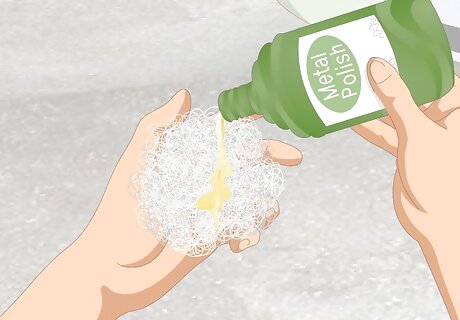
Squirt some of your polish into a foam pad or ultra-fine steel wool. Use a foam pad if your wheels aren’t dirty at all after cleaning. Otherwise, use a 4–8 in (10–20 cm) bunch of ultra-fine steel wool. Take your container of polish and squirt a 2–3 in (5.1–7.6 cm) line of the gel on to the surface of your foam pad or steel wool.Variation: For extremely dirty wheels, use a drill with a foam attachment instead of a foam pad or steel wool. Insert the foam attachment into your drill bit and turn the drill to the lowest setting to make the foam pad spin. Unless your vehicle is extremely dirt though, this shouldn’t be necessary. It is absolutely essential that you use ultra-fine steel wool instead of fine, medium, or coarse varieties. Ultra-fine steel wool will work the polish deep into the chrome without scratching it, but other types of steel wool will scratch or damage your chrome. Ultra-fine steel wool has 0000 on the packaging to indicate that it’s ultra-fine. Ultra-fine steel wool is often marketed at super-fine.
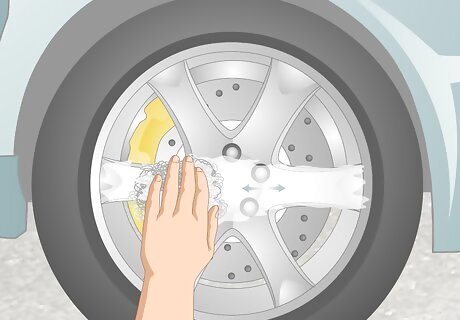
Apply the polish to the chrome and rub back-and-forth. Once you’ve squeezed a line of polish into your steel wool, press the surface of the wool into any area near the edge of your rim. Use back-and-forth strokes to force the polish into the chrome. For curved surfaces, use elliptical strokes to apply the polish. Cover each area that you’re scrubbing 3-4 times to ensure that every portion of your chrome absorbs some polish. You will see the polish foam up a little as you apply it. For hard-to-reach areas, do your best to reach the area with your steel wool or foam pad and gently brush the surface with your applicator.
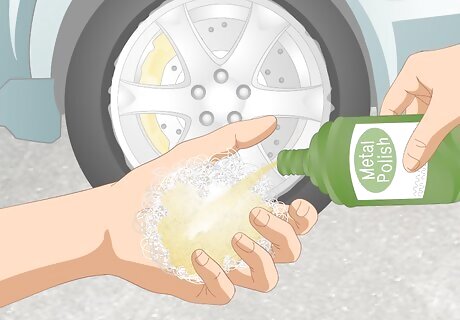
Reload your steel wool or foam pad as needed and finish applying the polish. As the polish starts to thin out and the foam becomes less bubbly, reload your steel wool with more polish. Continue the application process by applying the polish to the rest of your wheel. Reload the steel wool or foam pad as often as needed to finish covering your wheels. A 2–3 in (5.1–7.6 cm) length of polish will clean roughly half of a 20 in (51 cm) rim. You may need to reload your steel wool or foam pad 8-12 times to cover all of your wheels.
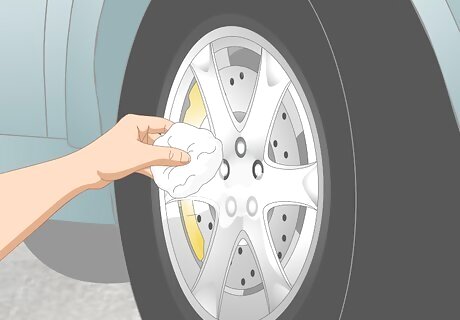
Use a soft cloth to rub the excess polish off. Grab a large, clean cloth and hold it comfortably in your dominant hand. Rub each surface that you polished to remove the excess gel. You don’t need to rub particularly hard to lift the foamy material up. Continue rubbing your wheels until the excess polish is completely removed. The polish will leave a thin veneer behind on your wheels. This is a good thing, so don’t worry if your wheels feel like they have a slightly smoother texture when you touch them.
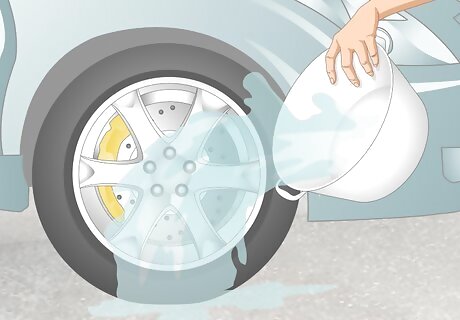
Rinse your wheels with water to remove any foreign contaminants. Your foam pad, steel wool, or foam attachment will inevitably leave some particles behind on your wheel. To clean this residue off, hose your wheels down or use buckets of room-temperature water to rinse the wheels off. Use a dry cloth to wipe the excess water off after you’re done. Your wheels will remain shiny and clean for 3-12 months depending on how often you drive and what kind of weather your wheels are exposed to. Repeat this process at least once a year to ensure that your chrome stays shiny and pristine




















Comments
0 comment